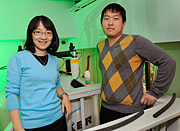- Number 326 |
- December 6, 2010
Discovering how the flu virus infects healthy cells

Mei Hong of the Ames
Laboratory and Iowa State
University, left, and Fanghao
Hu of Iowa State used solid-state
nuclear magnetic resonance
spectroscopy to investigate
the proton channel that
connects a flu virus to a healthy
cell.
Science is closer to understanding how the flu virus infects healthy cells thanks to researchers at the Ames Laboratory. The team, led by Mei Hong, associate scientist and an Iowa State professor of chemistry used solid-state nuclear magnetic resonance (NMR) spectroscopy to determine the structure and workings of a proton channel that connects the flu virus to a healthy cell.
The flu virus uses a shuttle mechanism to relay protons through the proton channel in a process necessary for the virus to infect a host cell according to findings published in the Oct. 22 issue of the journal Science.
That proton channel is an important part of the life cycle of a flu virus. The virus begins an infection by attaching itself to a healthy cell. The healthy cell surrounds the virus and takes it inside through a process called endocytosis. Once inside the cell, the virus uses a protein called M2 to open a channel. Protons from the healthy cell flow through the channel into the virus and raise its acidity. That triggers the release of the virus' genetic material into the healthy cell. The virus then hijacks the healthy cell's resources to replicate itself.
According to Hong, a full understanding of the mechanism could help medical researchers design drugs that stop protons from moving through the channel.
[Kerry Gibson, 515.294.1405,
kgibson@ameslab.gov]
